AMD A10-5800K & A8-5600K Review: Trinity on the Desktop, Part 1
by Anand Lal Shimpi on September 27, 2012 12:00 AM ESTCompute & Synthetics
One of the major promises of AMD's APUs is the ability to harness the incredible on-die graphics power for general purpose compute. While we're still waiting for the holy grail of heterogeneous computing applications to show up, we can still evaluate just how strong Trinity's GPU is at non-rendering workloads.
Our first compute benchmark comes from Civilization V, which uses DirectCompute 5 to decompress textures on the fly. Civ V includes a sub-benchmark that exclusively tests the speed of their texture decompression algorithm by repeatedly decompressing the textures required for one of the game's leader scenes. And while games that use GPU compute functionality for texture decompression are still rare, it's becoming increasingly common as it's a practical way to pack textures in the most suitable manner for shipping rather than being limited to DX texture compression.
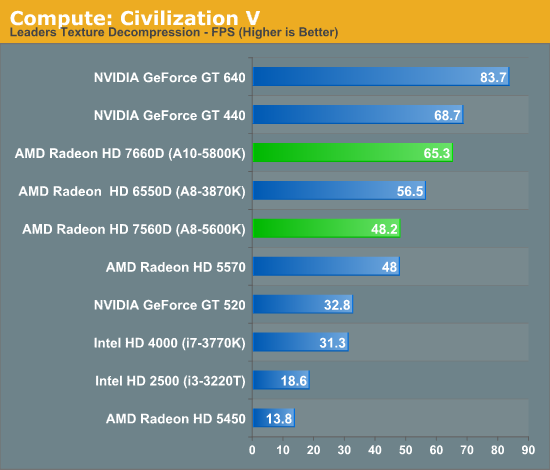
Similar to what we've already seen, Trinity offers a 15% increase in performance here compared to Llano. The compute advantage here over Intel's HD 4000 is solid as well.
Our next benchmark is SmallLuxGPU, the GPU ray tracing branch of the open source LuxRender renderer. We're now using a development build from the version 2.0 branch, and we've moved on to a more complex scene that hopefully will provide a greater challenge to our GPUs.
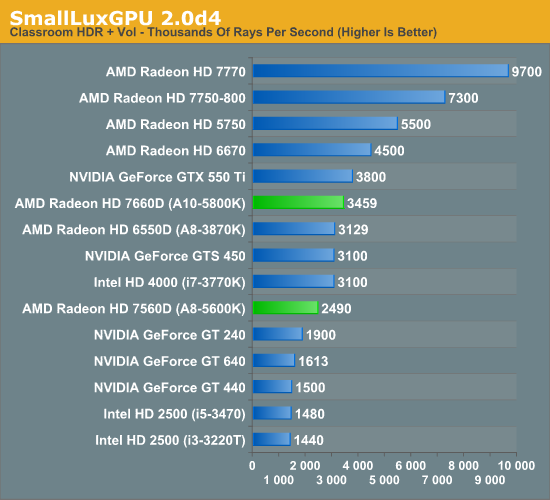
Intel significantly shrinks the gap between itself and Trinity in this test, and AMD doesn't really move performance forward that much compared to Llano either.
For our next benchmark we're looking at AESEncryptDecrypt, an OpenCL AES encryption routine that AES encrypts/decrypts an 8K x 8K pixel square image file. The results of this benchmark are the average time to encrypt the image over a number of iterations of the AES cypher. Note that this test fails on all Intel processor graphics, so the results below only include AMD APUs and discrete GPUs.
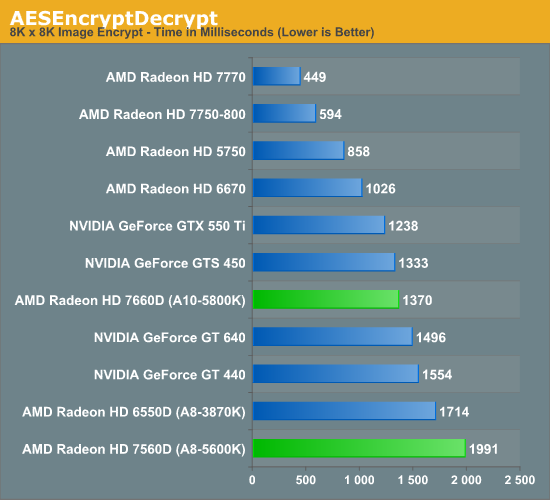
We see a pretty hefty increase in performance over Llano in our AES benchmark. The on-die Radeon HD 7660D even manages to outperform NVIDIA's GeForce GT 640, a $100+ discrete GPU.
Our fourth benchmark is once again looking at compute shader performance, this time through the Fluid simulation sample in the DirectX SDK. This program simulates the motion and interactions of a 16k particle fluid using a compute shader, with a choice of several different algorithms. In this case we're using an (O)n^2 nearest neighbor method that is optimized by using shared memory to cache data.
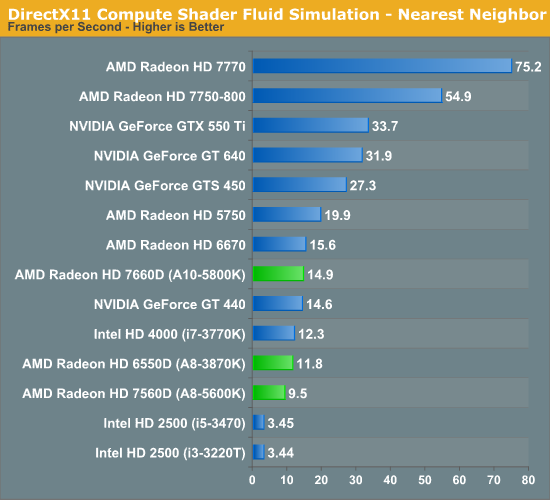
For our last compute test, Trinity does a reasonable job improving performance over Llano. If you're in need of a lot of GPU computing horsepower you're going to be best served by a discrete GPU, but it's good to see the processor based GPUs inch their way up the charts.
Synthetic Performance
Moving on, we'll take a few moments to look at synthetic performance. Synthetic performance is a poor tool to rank GPUs—what really matters is the games—but by breaking down workloads into discrete tasks it can sometimes tell us things that we don't see in games.
Our first synthetic test is 3DMark Vantage's pixel fill test. Typically this test is memory bandwidth bound as the nature of the test has the ROPs pushing as many pixels as possible with as little overhead as possible, which in turn shifts the bottleneck to memory bandwidth so long as there's enough ROP throughput in the first place.
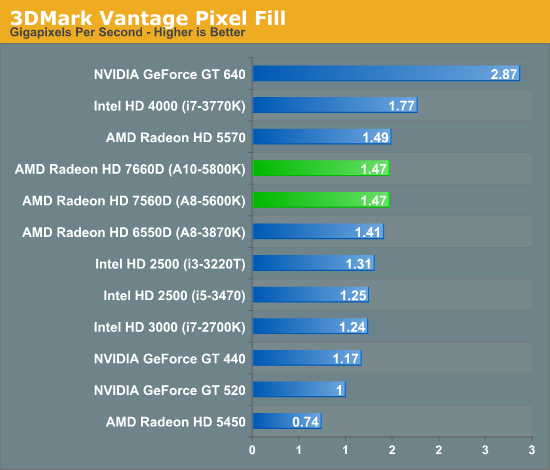
Since our Llano and Trinity numbers were both run at DDR3-1866, there's no real performance improvement here. Ivy Bridge actually does quite well in this test, at least the HD 4000.
Moving on, our second synthetic test is 3DMark Vantage's texture fill test, which provides a simple FP16 texture throughput test. FP16 textures are still fairly rare, but it's a good look at worst case scenario texturing performance.

Trinity is able to outperform Llano here by over 30%, although NVIDIA's GeForce GT 640 shows you what a $100+ discrete GPU can offer beyond processor graphics.
Our final synthetic test is the set of settings we use with Microsoft's Detail Tessellation sample program out of the DX11 SDK. Since IVB is the first Intel iGPU with tessellation capabilities, it will be interesting to see how well IVB does here, as IVB is going to be the de facto baseline for DX11+ games in the future. Ideally we want to have enough tessellation performance here so that tessellation can be used on a global level, allowing developers to efficiently simulate their worlds with fewer polygons while still using many polygons on the final render.
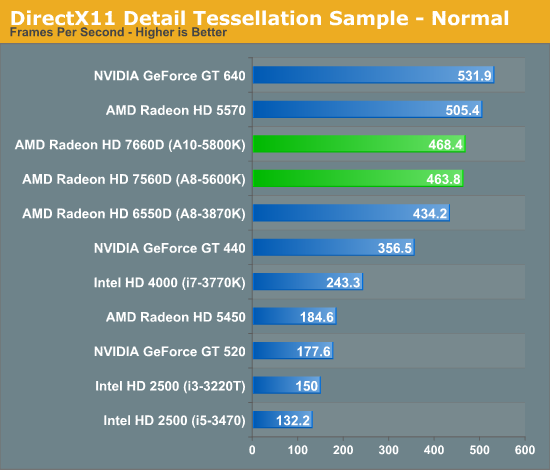
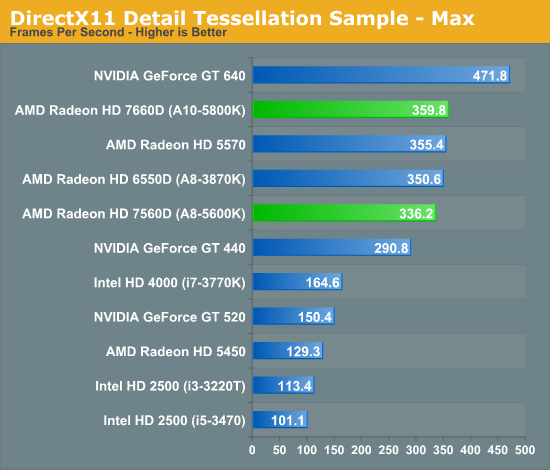
The tessellation results here were a bit surprising given the 8th gen tessellator in Trinity's GPU. AMD tells us it sees much larger gains internally (up to 2x), but using different test parameters. Trinity should be significantly faster than Llano when it comes to tessellation performance, depending on the workload that is.










139 Comments
View All Comments
Voldenuit - Thursday, September 27, 2012 - link
Agreed. If anything, AMD's PR moves are a faux pas, because it leads the reader to wonder just how bad their x86 performance might be if they have to go behind readers' backs to manipulate public perception by forcing reviewers to cherry pick benchmarks.In reality, I expect Trinity's x86 performance to be acceptable, but AMD's tiered benchmark and preferential treatment of reviewers sets a bad precedent for the industry that Anand should not have agreed to.
Hubb1e - Thursday, September 27, 2012 - link
Think of this like the launch of the AMD 7660 D graphics card then have a cup of tea, and maybe you will feel better about it.I'm happy to have something to read about. They didn't have to release anything until Oct 2nd.
It sounds like a pretty decent GPU. It's something I can toss in the wife's computer and guests could have a pretty decent expeirence when they come over and I don't even have to worry about that extra idle power consumption of a graphics card that goes unused by my wife.
But, look at those die sizes. Anand compares them to the i5 since it shows them in a more favorable light. Drop the Ivy i3 in that chart at 116mm2 and Trinity looks like the fat girl at a wet T-shirt contest. She's got the biggest jugs but the sacrifice to get there may not be worth it.
CeriseCogburn - Thursday, October 11, 2012 - link
AMD is an evil, vile corporate pig filled with lies and spinmeisters toying with the pliable minds of the immensely ignorant fanbase of haters it has carefully developed over many years.Now it has turned fully to the darkside and launched an attack from it's crumbling deathstar, an attack never seen before. It's the head pig destroyer of review sites.
Be proud amd fans, all those years you fed on your hatred of nVidia and Intel, yesss... feel the hatred... let it flow through you...
You're no Luke Skywalkers, you have given in to the darkside....
Anand Lal Shimpi - Thursday, September 27, 2012 - link
It's a bolder move than manufacturers have tried in the past, but it's not unheard of. Most company sanctioned pre-release reviews have some sort of restriction put on them. No pricing discussion is not unusual, the GPU-focus here is unusual but not totally out of the ordinary. The original Intel sanctioned Conroe performance previews were done similarly (Intel set and controlled the only applications that could be tested).The original press embargo for Trinity was in October. If you wanted to show something earlier, these were the rules. I'm not a huge fan of staggered embargoes, but they exist and this wasn't the first one. Had AMD tried at all to influence the benchmarks we ran, tests we used or conclusions we came to I guarantee you that things would've unfolded very differently.
Take care,
Anand
juampavalverde - Thursday, September 27, 2012 - link
Its a known move from the manufacturers, and knowing what happens with the NDA's its hard, but also its the case of a product with a performance hard to measure at least in the individual metrics, because has everything onboard, so i have no chance of getting any conclusion just knowing half of the data, i dont know how much of the power comes from the IGP, or the CPU, or how powerul is the GPU in comparison with others in an apples to apples test (i dont know if every GPU was tested over the APU or in another test rig), and if the piledriver quad its holding back the whole APU or it is doing right. From the performance measured in the IGP, its just a meh comparing to Llano, and not far enough from the HD 4000.AMD its MAD if they want to play Intel games. Intel can do it because they control the market, but being the underdog, performing unspectacular and behaving mad and bad... oh dear... they will be bought by Qualcomm when their stock go further down.
Voldenuit - Thursday, September 27, 2012 - link
Anand, thank you for taking the time to respond with your thoughts.I do agree with you that this behaviour is not unprecedented in the industry, and all camps (red, blue, green) have done it at some point or another.
However, when Conroe previews were released, they were clearly marked as such.
The Trinity reviews out now might be more properly termed as previews, since the part is not available and will not be for a couple more weeks.
At the end of the day, the performance will be nothing unusual or unexpected, since we've had mobile trinity parts benchmarked for a while.
What worries me is that staged and staggered reviews under NDA and exclusivity clauses may become the norm if the rest of the industry picks up on this practice and runs with it.
I also don't think this PR stunt has worked in AMD's favor - rather than highlighting its (well-earned) GPU prowess, it's raising questions about its x86 performance (which are probably very close to the mobile part's documented performance) and the (probably unintended) ethics of attempting to influence the review process.
tecknurd - Thursday, September 27, 2012 - link
After reading that article at techreport.com, I can not believe that Anandtech have resorted to obey AMD's rules of reviewing the latest products. I was wondering where is the general usage benchmarks and where is the encoding benchmarks. I thought this is a review site and not some teaser. If I was a reviewer, I would post the benchmarks of general usage which means going against the email. A reporter has every right post the truth. Where is the truth on this site?Like I comment on other sites, AMD arrogance is ruin their reputation and the reputation of reviewers.
BTW, I doubt the email will hold up in court, so it is OK to disobey it unless the contract is ambiguous.
SleepyFE - Thursday, September 27, 2012 - link
OMG.Forget the e-mail, they signed an NDA!!
And there is truth in the article, just not the whole truth. You don't post everything that happens to you on facebook do you? Some thing are left out for whatever reason Consider the NDA as AMD's privacy settings.
Jamahl - Thursday, September 27, 2012 - link
Scott also "previewed" conroe under the kinds of limitations Anand spoke about.http://techreport.com/review/9538/intel-conroe-per...
The main difference is he didn't complain bitterly about it. Techreport doesn't have the staff to get these kinds of reviews done in time, so instead they take the easy option by slagging off AMD.
MrSpadge - Thursday, September 27, 2012 - link
It's not review of the product, but it's a review of the GPU performance. Period.